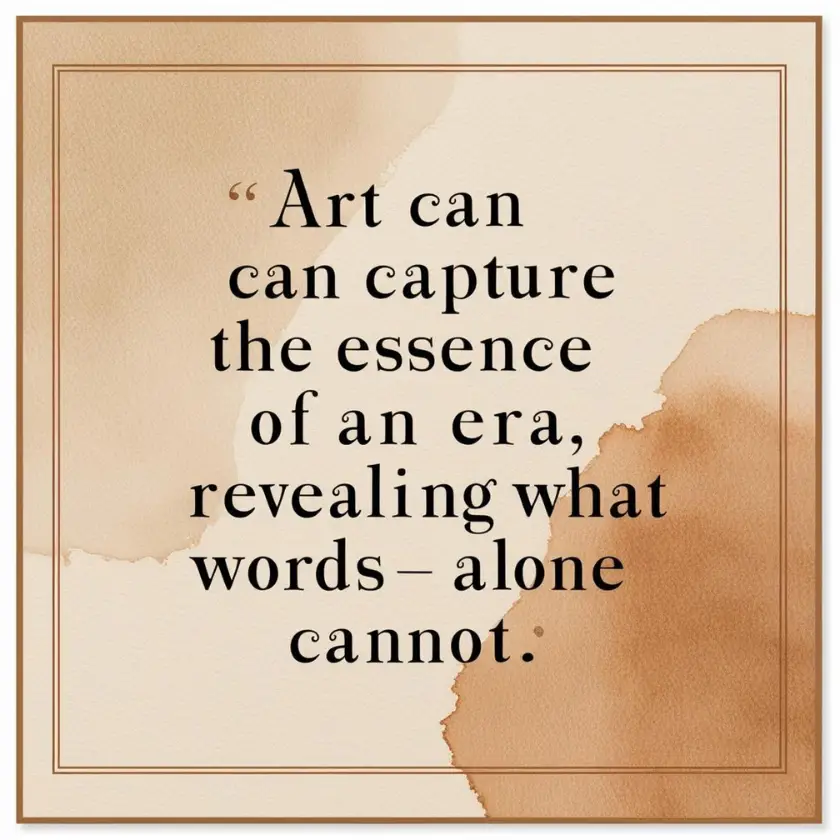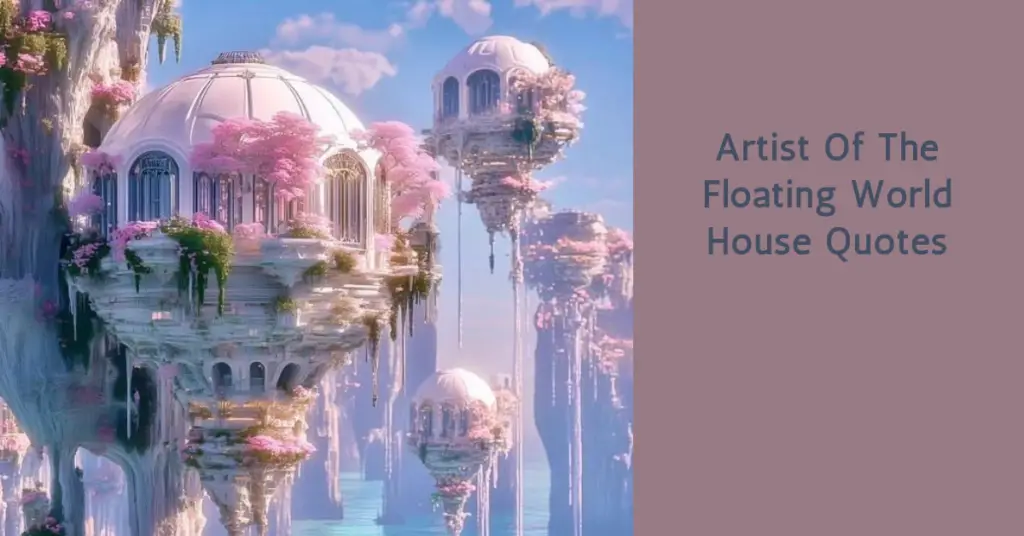Introduction
Artist Of The Floating World House Quotes captures moments of nostalgia and reflection. This blog dives into the profound words from the book. Each quote speaks volumes about life, choices, and the fleeting nature of time. If you love thought-provoking stories, this is for you.
The novel offers layers of meaning to uncover. Understanding the an artist of the floating world summary helps frame the context. It paints a vivid picture of post-war Japan. The house, as a central element, becomes a reflection of its owner’s journey. Exploring the symbols in an artist of the floating world deepens our appreciation of the story’s themes.
Memory plays a powerful role in the book. The weight of the past is everywhere. This makes memory in artist of the floating world a fascinating theme to explore. Through subtle storytelling, Kazuo Ishiguro creates moments of profound introspection. A closer look at an artist of the floating world analysis reveals layers of irony, regret, and hope.
And yes, irony is ever-present. It shapes the narrative and character experiences. The irony in artist of the floating world adds depth to its storytelling. Stick around as we explore these quotes and their meanings. Let them inspire, challenge, and move you.

Memory in An Artist of the Floating World
- “Memory, like a painting, can be distorted by time, but its essence remains.”
This reflects the protagonist’s experience in Artist Of The Floating World House Quotes, where his memories of the past are shaped by time and introspection. Just as time changes the appearance of a painting, it alters his recollection of events. - “Memories are not always reliable, yet they are the foundation of our identity.”
The unreliable nature of memory is central to the protagonist’s journey in Artist Of The Floating World House Quotes, where past events are revisited, often in contradictory ways, revealing the tension between personal history and self-perception. - “The house is a keeper of memories, each room echoing a part of the past.”
Just as Artist Of The Floating World House Quotes represent the protagonist’s psychological journey, his home houses the memories of his youth, which are revisited with nostalgia and regret. - “Every corner of a house holds a memory, and every memory has its own story to tell.”
This mirrors the way Artist Of The Floating World House Quotes weave together the protagonist’s fragmented memories, drawing connections between his past actions and present reflections. - “Some memories are like old paintings, faded but never forgotten.”
The fading of memories over time is a recurring theme in Artist Of The Floating World House Quotes, where the protagonist recalls significant events with increasing difficulty, yet they remain significant in shaping his identity. - “The weight of memory can fill a house, yet it is always lighter than the present moment.”
This illustrates the tension between past and present in Artist Of The Floating World House Quotes, where the protagonist’s memories sometimes feel burdensome, but the present offers an opportunity for understanding and growth. - “Memory is a canvas, and every day we paint new strokes.”
In Artist Of The Floating World House Quotes, the protagonist’s memories are like strokes on a canvas, constantly reshaped by his reflections and new realizations. These memories, once vivid, evolve into something more complex as he grapples with them. - “The past is always present in memory, just as every corner of a house reveals the past it once held.”
This aligns with Artist Of The Floating World House Quotes, where the protagonist’s home serves as a constant reminder of his past actions, which are never entirely out of reach, no matter how much he tries to move forward. - “We are all shaped by the memories we hold, and the house we live in echoes these memories.”
The home, as seen in Artist Of The Floating World House Quotes, acts as a mirror of the protagonist’s memories, reflecting both the joy and sorrow of his experiences and how they continue to define his identity. - “Some memories fade with time, but their impact on us remains.”
As in Artist Of The Floating World House Quotes, this reflects the protagonist’s understanding that, while some details of the past are lost, the emotional and moral impact of his actions still shapes who he is. - “The true essence of a house is not in its structure, but in the memories it holds.”
Just like in Artist Of The Floating World House Quotes, the home becomes symbolic of the protagonist’s memories, a place that is not only physical but also emotional, tied to the recollections that shape his worldview. - “Memory does not exist in isolation; it is always influenced by the spaces we occupy.”
This insight from Artist Of The Floating World House Quotes shows how the protagonist’s memories are deeply tied to his environment, emphasizing the symbiotic relationship between space and memory in his life. - “A house is more than a structure; it is a collection of memories that cannot be erased.”
This reinforces the idea found in Artist Of The Floating World House Quotes, where the protagonist’s home is a physical representation of his memories, holding both moments of personal significance and regret. - “The past and memory are not distant; they are in the very walls we live within.”
Similar to the symbolic role of the house in Artist Of The Floating World House Quotes, this statement reflects how memory and past experiences are always present, deeply intertwined with the environment and the protagonist’s daily life. - “Memory often distorts the past, yet we cling to it as a compass for the future.”
In Artist Of The Floating World House Quotes, the protagonist’s memories offer a compass of sorts, but these recollections are clouded by time, forcing him to reevaluate his role in a society that has changed drastically.
Understanding Memory in An Artist of the Floating World
- “Memories shape the landscapes we walk, just as they form the houses we inhabit.”
This quote highlights the central theme of memory in An Artist of the Floating World, emphasizing how past experiences shape identity and perception of the present. The reflection of memory in art and life resonates deeply throughout the narrative. - “Even the walls hold whispers of our choices, resonating with pride or regret.”
Exploring the role of memory, this quote ties into symbols in An Artist of the Floating World, illustrating how physical spaces in the novel serve as markers of the protagonist’s personal journey and societal changes. - “Revisiting the past is like walking through a house of mirrors, each reflection warped by time.”
This metaphor speaks to the unreliable nature of recollection, a theme central to the analysis of An Artist of the Floating World, where memory is shown to be both a refuge and a burden. - “The shadows on the wall are remnants of a world once vibrant and now fading.”
This evocative statement connects to an artist of the floating world summary, symbolizing the fleeting nature of glory and the introspection of the aging protagonist. - “A house built on memories cannot withstand the winds of self-deception.”
Here, the interplay between memory and truth is underscored, aligning with the irony in An Artist of the Floating World as the protagonist grapples with his legacy. - “The act of remembering is as artistic as the act of forgetting.”
This statement underscores the thematic tension in the novel, where memory in An Artist of the Floating World reveals the fluidity of truth and personal narrative. - “The floating world is more than a symbol; it is the very foundation of our shared illusions.”
This ties the title’s symbolism to the larger narrative, echoing symbols in An Artist of the Floating World and exploring how cultural and personal identities are intertwined. - “To remember is to rebuild, but the question is always whether the foundation was sound.”
This insight reflects the reflective tone of the novel, connecting to an artist of the floating world analysis by highlighting the protagonist’s struggle with self-reconciliation. - “Even in a house filled with light, the shadows of the past cannot be banished entirely.”
This speaks to the persistent presence of memory, aligning with the irony in An Artist of the Floating World, where the protagonist’s perceived pride clashes with societal disdain. - “Every brushstroke carries the weight of the past, even as it dreams of the future.”
Art becomes a medium for memory and aspiration, linking closely to memory in An Artist of the Floating World and its thematic exploration of legacy. - “In a floating world, the only anchor is the one we fashion for ourselves.”
This quote touches on personal agency amidst societal upheaval, a recurring theme in an artist of the floating world analysis, where the protagonist’s choices are critically examined. - “The past is not a foreign country; it is the architecture of our present existence.”
This profound observation connects to an artist of the floating world summary, encapsulating the novel’s meditation on memory and history. - “A house without windows cannot witness the passage of time.”
Symbolically, this quote ties into symbols in An Artist of the Floating World, where physical and metaphorical spaces reflect the characters’ emotional states. - “Art, like memory, preserves moments even as it transforms them.”
This statement bridges the themes of art and memory, central to memory in An Artist of the Floating World, portraying how the protagonist grapples with his artistic legacy. - “The floating world is not a place but a state of being, transient yet indelible.”
This encapsulates the novel’s title and theme, resonating with symbols in An Artist of the Floating World and the ephemeral nature of cultural and personal identity.

Reflections on Memory in An Artist of the Floating World
- “Memories are like rooms within a house, each with its own story to tell.”
This metaphor emphasizes the intricate connections between memory and identity, often symbolized through the house in the narrative. Such imagery enhances the depth of Artist Of The Floating World House Quotes, showcasing how the protagonist’s home becomes a canvas for his reflections. - “The walls of a house remember the voices of those who lived within them.”
This thought parallels the narrative’s exploration of memory and the lasting impact of the past. It illustrates the essence of Artist Of The Floating World House Quotes, as the protagonist uses his surroundings to interpret his shifting place in society. - “A home is more than bricks; it’s a repository of dreams and regrets.”
The house stands as a metaphor for the protagonist’s emotional and moral journey, tying closely to the poignant themes expressed in Artist Of The Floating World House Quotes and the protagonist’s artistic evolution. - “Every corner of the house carries a whisper of unspoken truths.”
This aligns with the layered meanings in Artist Of The Floating World House Quotes, where the house mirrors the complexity of unresolved emotions and unacknowledged realities. - “In a house filled with art, even the silence speaks volumes.”
This statement highlights the role of creativity in interpreting life’s events, reflecting the subtle interplay between personal spaces and memory seen in Artist Of The Floating World House Quotes. - “A well-lived house bears the marks of its inhabitants’ joys and sorrows.”
Connecting to the themes of impermanence and legacy, this insight resonates with Artist Of The Floating World House Quotes, where each space reveals a layer of the protagonist’s intricate narrative. - “The architecture of a house mirrors the architecture of the soul.”
This sentiment encapsulates the protagonist’s introspective journey, echoed in Artist Of The Floating World House Quotes, where the home is both a sanctuary and a site of reckoning. - “A house cannot escape its past, just as we cannot escape ours.”
Reflecting the weight of memory, this quote integrates with Artist Of The Floating World House Quotes, showing how the protagonist’s home becomes a symbol of his inner struggles. - “Even in the smallest details, a house holds echoes of the life it has seen.”
The nuanced portrayal of domestic spaces enhances the themes in Artist Of The Floating World House Quotes, emphasizing how the mundane becomes meaningful in the context of memory. - “To rebuild a house is to confront its history, just as to reflect is to confront the self.”
This analogy underlines the role of reflection in personal growth, central to Artist Of The Floating World House Quotes, and the protagonist’s reckoning with his past choices. - “Art transforms a house into a living archive of experience.”
This statement ties the theme of art to memory and space, integral to Artist Of The Floating World House Quotes, illustrating how creativity preserves fleeting moments. - “A house stands witness to the passage of time, as silent as a painting in a gallery.”
This connects deeply with Artist Of The Floating World House Quotes, where the house becomes a metaphor for enduring legacies amid societal change. - “Within every house lies a story waiting to be told.”
Reflecting the narrative’s emphasis on storytelling, this sentiment aligns with the evocative themes in Artist Of The Floating World House Quotes, highlighting how spaces inspire introspection. - “A house is a canvas, and life paints its story in every room.”
This visual imagery mirrors the protagonist’s artistic approach, tying into Artist Of The Floating World House Quotes, and the intertwining of art, memory, and identity. - “In the stillness of a house, the echoes of the past become unmistakable.”
This profound observation encapsulates the essence of Artist Of The Floating World House Quotes, where silence and reflection bring hidden truths to light.
The Role of Symbols in An Artist of the Floating World
- “Symbols are the brushstrokes that bring meaning to the canvas of life.”
This mirrors how symbols in Artist Of The Floating World House Quotes act as anchors for the protagonist’s understanding of his identity and past. Symbols play a central role in expressing the novel’s themes of memory, identity, and societal change. - “In every symbol, there lies a hidden truth waiting to be uncovered.”
The use of symbolic imagery in the novel allows readers to explore deeper meanings beneath the surface. This is akin to how Artist Of The Floating World House Quotes invite introspection into the protagonist’s evolving relationship with his environment. - “A house full of symbols is a house full of untold stories.”
Just as the protagonist’s home reflects his artistic and personal journey, symbols within the house become carriers of untold truths. These symbols, explored in Artist Of The Floating World House Quotes, reflect the protagonist’s unresolved past. - “Each object in a house holds a symbol of something greater.”
The relationship between symbols and spaces is crucial in understanding the protagonist’s inner world. In Artist Of The Floating World House Quotes, symbols become metaphors for the complexity of human experience. - “Through symbols, we communicate what words cannot express.”
This quote reflects how the protagonist in Artist Of The Floating World House Quotes uses symbols to articulate emotions and ideas that go beyond verbal expression, echoing the deep layers within the narrative. - “Symbols can break the silence of a house, revealing the secrets it holds.”
Symbolism often brings the hidden aspects of a person’s life to the forefront. In Artist Of The Floating World House Quotes, symbols are tools of revelation, helping the protagonist understand his past choices. - “Like a well-crafted symbol, a house holds many interpretations depending on the viewer.”
This mirrors the interpretive nature of Artist Of The Floating World House Quotes, where the protagonist’s living space symbolizes his shifting role in a post-war society. - “Every room in a house tells a different story through the symbols it holds.”
The rooms in Artist Of The Floating World House Quotes represent various chapters of the protagonist’s life, with each symbol adding a layer of depth to his personal narrative. - “A house can be a sanctuary or a prison, depending on the symbols it contains.”
This duality of symbols within a home mirrors the protagonist’s internal conflict. In Artist Of The Floating World House Quotes, his home reflects his struggles to reconcile his past actions with his present reality. - “Symbols are the silent storytellers of every house.”
The use of symbols in Artist Of The Floating World House Quotes aligns with how objects and spaces communicate the complex emotions of the protagonist, without ever needing to be vocalized. - “The home is full of subtle symbols that speak louder than any words.”
This resonates with the idea in Artist Of The Floating World House Quotes, where the home is a silent witness to the protagonist’s changing perspective and his journey towards redemption. - “Symbols in a house can carry the weight of generations.”
Just as Artist Of The Floating World House Quotes reflect the emotional and historical weight of the protagonist’s environment, symbols embedded in the house help to communicate the legacy of past generations. - “In every house, there is a symbol of life, love, and loss.”
This quote aligns with the emotional significance of Artist Of The Floating World House Quotes, where each symbol in the protagonist’s home has a story to tell about the broader human experience. - “Symbols breathe life into the forgotten corners of a house.”
The forgotten aspects of a home come alive through symbols, just as in Artist Of The Floating World House Quotes, the protagonist’s reflections on his home uncover long-buried emotions and memories. - “Symbols are the language of the soul, speaking in ways words never could.”
In Artist Of The Floating World House Quotes, symbols become the ultimate form of communication, allowing the protagonist to navigate his identity and confront his past.
An Artist of the Floating World Summary
- “The artist’s journey is not only of creation but of self-revelation.”
This connects with the an artist of the floating world summary, where the protagonist’s journey is not just about his art, but about his reflection on his role in post-war Japan. His self-awareness grows as he confronts both his artistic legacy and his moral choices during the war. - “Art mirrors life, but the truth behind the artist’s life is often concealed by their creations.”
In an artist of the floating world summary, the protagonist’s art hides the complexities of his life. As he navigates his past, he grapples with understanding how much of his personal narrative is embedded in his art and how it shapes his identity. - “Sometimes the biggest obstacles are the ones we create for ourselves.”
This quote reflects the an artist of the floating world summary, where the protagonist is trapped by his own creations, unable to fully escape the repercussions of his actions during the war. His own self-deception keeps him from reconciling with the past. - “In the search for meaning, the artist often loses sight of the very thing that gave him purpose.”
This echoes an artist of the floating world summary, where the protagonist begins questioning the purpose of his life and work, especially as the world around him changes, leaving him disillusioned. His identity, once tied to his art, begins to feel disconnected from the present. - “The weight of the past can crush even the most revered artists.”
This resonates with the an artist of the floating world summary, where the protagonist’s past actions continue to haunt him. Despite his previous fame, the consequences of his decisions during the war weigh heavily on his conscience, leading to his eventual downfall. - “A true artist faces the mirror not just to reflect their work, but their soul.”
The an artist of the floating world summary is reflected in this statement, where the protagonist’s reflection in his art shows more than just external skills. It reveals the complexities of his inner life and the tension between his personal growth and moral failings. - “The passage of time distorts not only memories but the interpretation of an artist’s work.”
This quote speaks to an artist of the floating world summary, where the protagonist revisits his past work and finds that, with time, his perspective on his art and his actions has drastically changed, just as public opinion has shifted about him. - “In understanding the artist’s work, we must first understand the man behind it.”
This aligns with an artist of the floating world summary, where the protagonist’s art is inseparable from his personal journey. To understand his work fully, we must first understand the moral and emotional struggles that shaped his life. - “The artist’s role is not to simply create but to provoke thought and reflection in others.”
In the an artist of the floating world summary, the protagonist’s art is no longer seen as just a product of beauty but as a tool for reflection. It questions the morals and values of the society in which it was created, ultimately forcing the artist to reconsider his own beliefs. - “An artist’s legacy is built not just on what they create, but on how they evolve.”
This statement ties directly to the an artist of the floating world summary, as the protagonist’s legacy is shaped by his ability to change over time. His personal evolution reflects in his art, and the perception of his legacy is tied to his ability to adapt and evolve morally and artistically. - “Sometimes the greatest art is the one left unfinished.”
This resonates with the an artist of the floating world summary, where the protagonist’s artistic journey feels incomplete due to his growing doubts and the social changes around him. His inability to finish certain parts of his life mirrors his struggle to complete his artistic legacy. - “An artist is forever bound by the interpretations others place on his work.”
In an artist of the floating world summary, the protagonist faces the consequences of how others interpret his work. His past art, which once seemed noble and honorable, is now seen through the lens of the present, causing him to reconsider its meaning. - “To understand the artist’s work is to understand the culture in which it was created.”
This statement highlights the an artist of the floating world summary, where the protagonist’s art reflects not just his personal views but also the cultural and historical context in which it was created. As the world changes, his art loses its original significance. - “Time not only changes the artist’s perception but the perception of the artist’s work.”
This perfectly aligns with the an artist of the floating world summary, where the protagonist’s retrospective view of his past actions and art contrasts sharply with how it was perceived at the time. Time has altered both the art and its interpretation. - “An artist’s true work is not measured by accolades, but by the impact they leave on the world.”
This quote speaks to an artist of the floating world summary, where the protagonist’s true impact is not the fame he once enjoyed but the enduring question of how his art and choices affected the course of history and the people around him.

Symbols in an Artist of the Floating World
- “Art can capture the essence of an era, revealing what words alone cannot.”
This speaks to symbols in an artist of the floating world, where the protagonist’s artwork represents a moment in time. His pieces act as symbols of pre-World War II Japan, embodying the cultural and historical atmosphere that he experienced and depicted. - “The brushstrokes of an artist can tell stories that silence the voices of history.”
In symbols in an artist of the floating world, the protagonist’s art serves as a symbol of Japan’s artistic legacy. The brushstrokes become a silent yet powerful medium to represent a culture and time that has now faded into the past. - “A symbol can carry the weight of a thousand words, yet remain elusive.”
The symbols in an artist of the floating world carry deep meaning, often seen as more than just visual art but as representations of personal and national identity. These symbols act as a coded language, carrying personal and historical weight that is left to interpretation. - “The symbols we choose often reflect our deepest fears and desires.”
In symbols in an artist of the floating world, the protagonist’s choice of subjects, like the geisha and beautiful landscapes, symbolizes a longing for a time that has passed. His works reflect both his personal nostalgia and the political complexities of the era. - “A work of art is not just an image, but the soul of a culture.”
This resonates with the symbols in an artist of the floating world, where the protagonist’s paintings symbolize more than just beauty—they represent the fading values of the pre-war Japanese society, capturing its ideals before they were irrevocably changed. - “The true symbol of an artist’s life is not found in the accolades, but in the moments they capture.”
In symbols in an artist of the floating world, the artist’s true legacy lies not in his fame but in the symbols he imbues within his paintings. These symbols reveal his understanding of society’s fleeting nature and the tensions between modernity and tradition. - “Art has a peculiar way of symbolizing the invisible—the unseen emotions that govern us.”
In symbols in an artist of the floating world, the protagonist’s paintings capture the hidden emotions of a society on the brink of change. His art symbolizes the conflicting emotions of nostalgia, regret, and the loss of innocence. - “Symbols are not always clear; they require interpretation to reveal their true meaning.”
Reflecting symbols in an artist of the floating world, the protagonist’s work is often ambiguous. The symbols within his art demand interpretation, as each viewer may understand the piece differently, depending on their perspective of the era’s politics and social changes. - “Through symbols, the artist communicates with the past, present, and future.”
In symbols in an artist of the floating world, the protagonist’s art communicates not only with the people of his time but with generations to come. The symbols embedded in his work serve as a bridge between Japan’s historical past and its uncertain future. - “Every piece of art carries with it the weight of the era in which it was created.”
This resonates with symbols in an artist of the floating world, where the protagonist’s paintings are not just personal expressions but carry the weight of an era. His symbols represent the turmoil, pride, and guilt of a society facing the consequences of its actions during wartime. - “The artist captures not just the world as it is, but the world as it could be seen.”
In symbols in an artist of the floating world, the protagonist’s work reflects an idealized view of the world, emphasizing his personal vision rather than the stark realities of post-war Japan. His symbols act as a refuge for his memories, even if they are disconnected from current reality. - “Symbols are a language of their own, speaking to those willing to listen.”
In symbols in an artist of the floating world, the protagonist’s use of symbols in his art serves as a form of communication that speaks beyond words. Those who are willing to understand these symbols can grasp the nuances of his internal conflict and societal disillusionment. - “The artist’s symbols reflect their deepest understanding of life’s contradictions.”
Reflecting the themes of symbols in an artist of the floating world, the protagonist’s work contains symbols that reveal the contradictions of his life. His art simultaneously celebrates the beauty of a bygone era while acknowledging the guilt and complexities of his own past. - “A symbol can both reveal and conceal; it is the artist’s way of holding a secret.”
This idea connects with symbols in an artist of the floating world, where the protagonist uses symbols to tell a story that he cannot fully articulate. His art is a form of storytelling, concealing parts of the truth and revealing only what he is willing to admit.

Memory in Artist of the Floating World
- “The past is a shadow, following us but never quite within reach.”
In memory in artist of the floating world, the protagonist often reflects on his past with nostalgia, yet he realizes that the full truth of those memories is elusive. His recollections of the past are clouded by time and selective memory, and they create a tension between what was and what is now. - “Memories are like paintings—they fade with time, but they still carry the hues of our emotions.”
This reflects memory in artist of the floating world, where the protagonist’s recollections are intertwined with the emotional weight of his art. His memories of pre-war Japan are deeply colored by the idealized versions of the world he depicted in his paintings, creating a longing for a time that has passed. - “Memory is the artist’s canvas, but it is not always true to the image it portrays.”
The protagonist’s memories, as explored in memory in artist of the floating world, are often distorted by time and his personal biases. Just as a painting can be subject to interpretation, his memories of the past are refracted through the lens of his current experiences and regrets. - “What we remember shapes who we are, but sometimes, the truth lies in what we forget.”
In memory in artist of the floating world, the protagonist’s selective memory plays a crucial role in how he sees himself and his world. His recollections often omit painful truths, allowing him to maintain a sense of self-deception and idealization of his past. - “The past is never truly gone—it lingers in our minds like an unfinished painting.”
This idea reflects memory in artist of the floating world, where the protagonist’s memories of a more glorious time in Japan continue to haunt him. His mind, like an unfinished canvas, is full of unresolved feelings and reflections on his role in the era he lived through. - “Memory is both a gift and a curse; it preserves what we love, but also reminds us of what we’ve lost.”
In memory in artist of the floating world, the protagonist’s memories are a source of both comfort and pain. While they allow him to relive moments of joy and success, they also serve as a reminder of the changes in society and the disillusionment that followed the war. - “The line between memory and reality is often blurred; the artist’s work can be a reflection of both.”
This speaks to memory in artist of the floating world, where the protagonist’s art serves as a visual representation of his memories. However, his memories are not always accurate, and his artwork becomes a mixture of fact and fiction, idealization and regret. - “Memories are like waves—they can either wash over you or overwhelm you.”
The protagonist’s relationship with his memories in memory in artist of the floating world is similar to the ebb and flow of the ocean. At times, memories are peaceful and comforting, but at others, they come crashing down, leaving him struggling to cope with the emotional aftermath. - “Memory is selective; it highlights the moments we cherish, but it also buries the painful ones.”
In memory in artist of the floating world, the protagonist’s selective memory shapes his perception of the past. He clings to the moments of beauty and success but distances himself from the more painful truths that might challenge his constructed narrative of his life. - “Our memories shape our identity, but we are not always the sum of what we remember.”
In memory in artist of the floating world, the protagonist’s memories influence how he perceives himself and his role in history. However, as he confronts the complexities of the present, he realizes that his memories alone do not define who he is or the legacy he leaves behind. - “The memories we hold onto are not always the ones we need.”
In memory in artist of the floating world, the protagonist struggles with holding onto memories that no longer serve him. His attachment to the past keeps him from moving forward, and he must come to terms with letting go of certain recollections to find peace. - “We are all the sum of our memories, but those memories are not always the full story.”
This ties into memory in artist of the floating world, where the protagonist’s understanding of his life and his role in history is shaped by his memories. However, these memories are partial and unreliable, leaving gaps in his understanding of both himself and the world he inhabited. - “The past may be gone, but the memory of it shapes the future.”
This highlights the importance of memory in artist of the floating world, where the protagonist’s recollections of a more glorious time in Japan continue to influence his view of the future. His memories shape his current relationships and his understanding of the post-war world. - “Memory is a gallery of moments, some painted with light, others with darkness.”
Reflecting memory in artist of the floating world, the protagonist’s memories are filled with moments of joy and sorrow, light and shadow. His art attempts to capture these moments, but the complexity of memory ensures that some aspects remain elusive, haunting him long after the events have passed.






